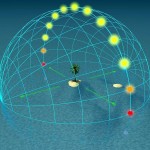
The illustration at top by Tau’olunga via Wikimedia Commons shows the day arc of the sun, every hour – during the equinoxes – as seen on the celestial dome from the equator. Also showing twilight suns down to -18 degrees latitude. Note the sun is at the zenith at noon and that the tree’s shadow is cast straight down. That is – as seen from the equator on the day of an equinox – a tree stands in the center of its own shadow.
The 2020 autumnal equinox for the Northern Hemisphere (spring equinox for the Southern Hemisphere) happens on Tuesday, September 22, at 13:31 UTC. At this special moment – the instant of the September equinox – the sun is at zenith, or straight overhead, as seen from Earth’s equator.
That’s the meaning of an equinox. The September equinox sun crosses the sky’s equator, going from north to south.
Donate: Your support means the world to us
Although the equinox happens at the same instant for everyone worldwide, the clock time for the equinox varies by time zone. In the U.S., the local clock time for the September equinox will be Tuesday, September 22, at 9:31 a.m. EDT, 8:31 a.m. CDT, 7:31 a.m. MDT and 6:31 a.m. PDT.
On the day of the equinox, the sun pretty much rises due east and sets due west all over the world, with everyone worldwide receiving approximately equal portions of day and night.
When October comes rolling around, that’ll change dramatically. By then, the sun will rise noticeably south of due east and will set noticeably south of due west. That’ll mean shorter days and longer nights for the Northern Hemisphere, and longer days and shorter nights in the Southern Hemisphere.
After the equinox, the sun (and migrating birds) will continue to travel southward to the southern climes. Arctic sea ice will begin to freeze; Antarctic ice will start melting. The great wheel of the seasons will continue to turn.
How to celebrate?
Try to watch as the sun rises due east and sets due west on the day of the equinox. If you do that from your backyard, or deck, or a local park – somewhere that you have familiar landmarks – you’ll gain a handy tool for astronomy: that is, the tool of knowing the direction of due east.
Bottom line: Around the equinox, the sun is overhead at noon for people at Earth’s equator.
Read more: Everything you need to know about the September equinox 2020
from EarthSky https://ift.tt/2AEQ2Nn

The illustration at top by Tau’olunga via Wikimedia Commons shows the day arc of the sun, every hour – during the equinoxes – as seen on the celestial dome from the equator. Also showing twilight suns down to -18 degrees latitude. Note the sun is at the zenith at noon and that the tree’s shadow is cast straight down. That is – as seen from the equator on the day of an equinox – a tree stands in the center of its own shadow.
The 2020 autumnal equinox for the Northern Hemisphere (spring equinox for the Southern Hemisphere) happens on Tuesday, September 22, at 13:31 UTC. At this special moment – the instant of the September equinox – the sun is at zenith, or straight overhead, as seen from Earth’s equator.
That’s the meaning of an equinox. The September equinox sun crosses the sky’s equator, going from north to south.
Donate: Your support means the world to us
Although the equinox happens at the same instant for everyone worldwide, the clock time for the equinox varies by time zone. In the U.S., the local clock time for the September equinox will be Tuesday, September 22, at 9:31 a.m. EDT, 8:31 a.m. CDT, 7:31 a.m. MDT and 6:31 a.m. PDT.
On the day of the equinox, the sun pretty much rises due east and sets due west all over the world, with everyone worldwide receiving approximately equal portions of day and night.
When October comes rolling around, that’ll change dramatically. By then, the sun will rise noticeably south of due east and will set noticeably south of due west. That’ll mean shorter days and longer nights for the Northern Hemisphere, and longer days and shorter nights in the Southern Hemisphere.
After the equinox, the sun (and migrating birds) will continue to travel southward to the southern climes. Arctic sea ice will begin to freeze; Antarctic ice will start melting. The great wheel of the seasons will continue to turn.
How to celebrate?
Try to watch as the sun rises due east and sets due west on the day of the equinox. If you do that from your backyard, or deck, or a local park – somewhere that you have familiar landmarks – you’ll gain a handy tool for astronomy: that is, the tool of knowing the direction of due east.
Bottom line: Around the equinox, the sun is overhead at noon for people at Earth’s equator.
Read more: Everything you need to know about the September equinox 2020
from EarthSky https://ift.tt/2AEQ2Nn

Aucun commentaire:
Enregistrer un commentaire